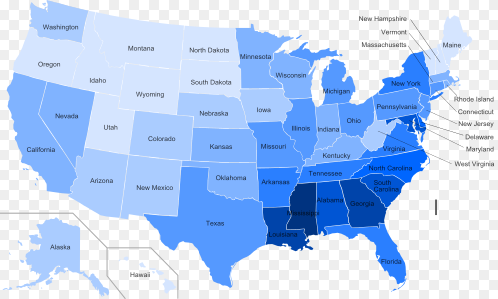Thermodynamics and Society
by Jake Conner
for Physics 212
4/24/2017
Sample Case
Science!
Conclusion?
Bibliography
The Science
Now that we have an idea what factors should effect our theoretical heat engine we should attempt to assign some actual values to them. How should we measure, "percieved need for change," though? We need to somehow count the number of people who believed some change was necessary and the number of people who cared the least.
Clearly the people who are most affected by the matters at hand should be the ones at the upper extreme, (the hot side of the heat engine diagram.) But what about the cold side? Somehow we need to figure out what the least desire for change was among the population across the United States during the 1960's and 50's.
If we think of the United States as a big mass of people with some affected by these issues and others who are not affected then the extremes should be the places with the highest ratios of affected or unaffected people respectively.

From the map we can see that the highest density of African Americans today is in Mississippi with a percentage of 35-40%. The Lowest density is less than 2% in the lighter colored regions. This isn't exactly what it was during the civil rights movement in the 60's but since there isn't much census data we can use from back then this will have to do.
Carrying out the calculations as before we have ...
Now, how should we measure change? Since the energy into the system must be equal to the energy out of it the effort is the change plus the hostility that was generated. The hostility is, as expected, difficult to measure. Taking the numbers of people who were injured, killed, or arrested we get the following ...
Now if we assume that every African American living in the country in the 60's was a benefactor of the movement, that is, 18,900,000 people, benefitting from the Civil Rights Act, Fair Housing Act, Voting Rights Act, and Immigration and Nationality Services Act we get.
Despite our incredibly high maximum efficiency the actual efficiency of this engine is beyond what should be possible and therefore the engine defies the laws of thermodynamics. This isn't entirely surprising though considering what little we actually know. It is difficult to place a real weight on the actual suffering of the victims during all of the rioting that took place or on all of the lives that were lost.
Now that we have an idea what factors should effect our theoretical heat engine we should attempt to assign some actual values to them. How should we measure, "percieved need for change," though? We need to somehow count the number of people who believed some change was necessary and the number of people who cared the least.
Clearly the people who are most affected by the matters at hand should be the ones at the upper extreme, (the hot side of the heat engine diagram.) But what about the cold side? Somehow we need to figure out what the least desire for change was among the population across the United States during the 1960's and 50's.
If we think of the United States as a big mass of people with some affected by these issues and others who are not affected then the extremes should be the places with the highest ratios of affected or unaffected people respectively.

By Ghislain Montvernay - U.S. Census Bureau, CC BY-SA 3.0, https://commons.wikimedia.org/w/index.php?curid=22621058
From the map we can see that the highest density of African Americans today is in Mississippi with a percentage of 35-40%. The Lowest density is less than 2% in the lighter colored regions. This isn't exactly what it was during the civil rights movement in the 60's but since there isn't much census data we can use from back then this will have to do.
Carrying out the calculations as before we have ...
Least desire = (0.02)*5, Most desire = (0.4)*5
Efficiency = 1 - (0.1)/2 = 0.95
Efficiency = 1 - (0.1)/2 = 0.95
Now, how should we measure change? Since the energy into the system must be equal to the energy out of it the effort is the change plus the hostility that was generated. The hostility is, as expected, difficult to measure. Taking the numbers of people who were injured, killed, or arrested we get the following ...
| Newark City riots: Harlem riots: Watts riot: Detroit riot of 1967: Total: | 2,253 583 4,504 509 7,849 |
Now if we assume that every African American living in the country in the 60's was a benefactor of the movement, that is, 18,900,000 people, benefitting from the Civil Rights Act, Fair Housing Act, Voting Rights Act, and Immigration and Nationality Services Act we get.
Change = 4*(18,900,000-7,849) = 75,568,604
Effort = 4*18,900,000 = 75,600,000
Change / Effort = 75,568,604 / 75,600,000 = 0.99
Effort = 4*18,900,000 = 75,600,000
Change / Effort = 75,568,604 / 75,600,000 = 0.99
Despite our incredibly high maximum efficiency the actual efficiency of this engine is beyond what should be possible and therefore the engine defies the laws of thermodynamics. This isn't entirely surprising though considering what little we actually know. It is difficult to place a real weight on the actual suffering of the victims during all of the rioting that took place or on all of the lives that were lost.